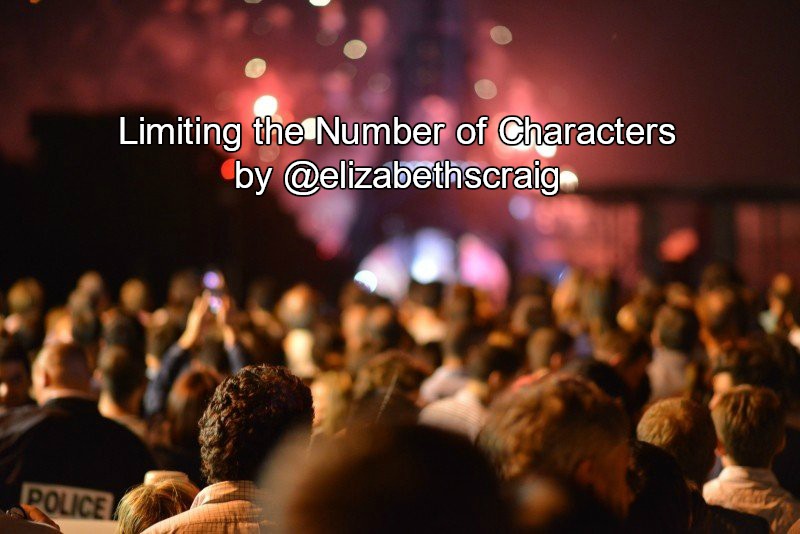by Elizabeth S. Craig, @elizabethscraig
This is the second post in a short series about making our lives easier as writers. One thing that I’ve tried to be more conscious of as the years have gone by is limiting the number of characters I introduce in a story or series.
With a cozy mystery series, for example, the field of characters is already going to be pretty crowded. You have a sleuth and a sidekick and around five suspects. And then you have recurring characters: friends and family of the sleuth and some sort of police presence.
The more characters we add, the harder it is for readers to keep up. And we run the risk of not having the space to make the characters more than one-dimensional.
One bit of advice is not to name every single character in your book. The waitress at the diner can just be the waitress. If we name her, we may be making her role in the story seem more important than it is…and leave readers trying to remember another name.
Another tip is to evaluate the number of characters you’re introducing. For my new series, I took a look to see if it was possible to combine roles. In one instance I could, which just meant that a character needed to help out with a cat rescue at the beginning of the book.
More reading about combining character roles can be found here:
Clare Langley-Hawthorne’s “A Cast of Thousands”
If you do have a large cast of characters even after combining roles, there are ways to help readers keep track of them. It’s a good idea to make characters distinguishable from each other by using quirks, diction, and recurring details about their physical appearance as reminders.
You can also tag supporting characters who haven’t been on stage for a while (Jane’s hairdresser, Sheri, opened the door). Or: Sheri walked in. “Long day at the beauty parlor, y’all. Three customers didn’t show up!”
More information on working with large casts of characters can be found here:
September C. Fawkes’ “Working With a Large Cast of Characters”
As a reader, do you ever have trouble keeping up with a lot of characters? As a writer, how do you try to help readers keep up (I’ve seen some books with a ‘cast of characters’ list at the front)?
Making Life Easier by Limiting the Number of Characters We Use: Click To TweetPhoto on Visual Hunt


You mean like a Game of Thrones cast?
I’ve tried to keep my character count reasonable. Besides, I’d have to keep track of all of them as well and it would confuse me.
Exactly like that, yes!
Tracking them is another thing that makes life complicated. What are they doing when they’re ‘offstage?’ It does get tricky.
You make some really well-taken points here, Elizabeth! It’so important to make the number of characters reasonable enough so that the reader can keep track of them and can be invested in them. Yet, you want enough characters to seem realistic and keep the interest up. It’s a bit of a tricky balance, isn’t it? I think it helps of the characters are clearly identifiable (e.g. X’s wife, or Y’s boss, or the local newspaper editor, or…).
Definitely! Tagging the characters briefly helps readers keep track of their places in the story.
Readers don’t want to keep a spread sheet just to keep up with everyone. Throwing a ton of characters at the reader right away isn’t good either. Especially if it’s fantasy and the names are weird to begin with. (I’ve read submissions like that.)
I think it makes it really hard, as a reader, to hop into a story if things seem really complex at the start.
I remember in some of the Agatha Christie books, she would make a ‘cast of characters’ at the front of the book to help keep it straight! I think mysteries definitely need more characters than some genres – tough to get just the right number!
She sure did! I relied on those character lists, too. :) (Which just goes to show that my memory wasn’t even good in my teen years, which is when I exhaustively read the books!)
Ken Folett’s Fall of Giants has its first 7 pages being the list of all the characters. I got a nosebleed just browsing it and thinking of having to remember all of them as a reader. How he weaved all those people into a comprehensible story is a wonder! I wonder if he got a nosebleed writing it.
I’ve written a few historical fantasies and so had to discover ways to do it entertainingly (At least I tried to be entertaining!)
I wish you had written this post sooner! :-)
I am now writing a flash fiction and have discovered the hard way that you cannot have an ensemble in that kind of writing! Ouch!!
As always a much needed post. Thanks, Elizabeth.
Three years ago, I wrote a post on how to do an ensemble novel which may prove helpful for those who are thinking of doing one:
https://rolandyeomans.blogspot.com/2016/01/how-to-write-ensemble-novel.html
Wow…7 pages for the characters? I only wish I had that kind of time!
Fantasy does have a large cast, I recall. I’m sure you worked it out entertainingly!
And thanks for sharing your resource for writers. :) Hope you have a great week!
Hi Elizabeth – just had to look up that Ken Follett book … it is a historical novel (as apparently are his others) so bearing in mind the eras he writes – it’s not surprising there are so many characters. Lots of history to learn too … but in general – too many characters do not the story make – while the ideas of your tips … a waitress, John’s gardener make a lot of sense … etc – thank you … cheers Hilary
Lots of characters can definitely make for a confusing read! Thanks so much for coming by, Hilary!